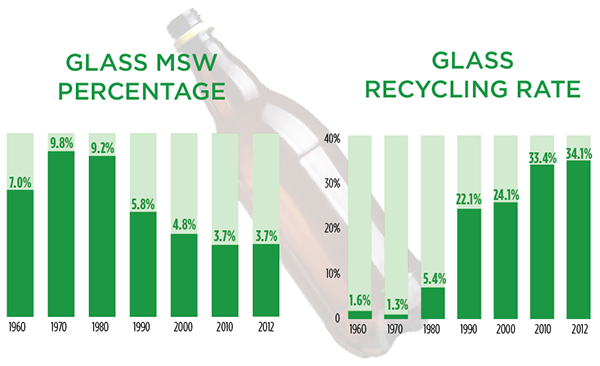Profiles in Garbage: Glass Containers
Glass containers are made from sand, limestone, soda ash, cullet (crushed bottles), and various additives, including those used to color brown, green or blue bottles.
More than half of the bottles produced in the United States are brown. Clear (also known as flint) bottles are the next largest in production. Most of the remainder are green with a small amount of blue or other colors.
In 2013, approximately 27.5 billion glass containers were made in the United States. Almost 80 percent were beverage containers, three quarters of which were beer bottles. The rest were bottles and jars for food products. An estimated 7 billion bottles were
imported. Most of these are green or brown wine and beer bottles.
Glass container use in the United States peaked in the 1980’s. Tonnage has declined by 4.7 million tons since 1980 as lighter weight aluminum and plastic containers have replaced glass bottles.
Other glass products such as window glass, fiberglass, and glassware use different manufacturing processes and different additives than container glass. This Profile does not cover non-container glass.
Glass Container Solid Waste Facts (2012 estimates)
Generated
9.38 million tons or 3.7 percent by weight.*
59.8 pounds per person per year.*
110 bottles per person per year.
Average glass bottle weighs 8 oz.
Recycled
3.2 million tons or 34.1 percent*
Ten states require deposits on glass beverage containers.
Those states have the highest tonnages and percentages of glass bottles recycled.
Recycled Content
A glass bottle can have up to 70 percent recycled content.
Current recycled content varies by plant and its access to cullet.
Composted
Glass does not compost.
Incinerated or Landfilled
6.18 million tons or 3.8 percent of discarded MSW by weight.*
Glass is inert in landfills.
Glass is non-combustible and generally forms a slag in incinerators.
Landfill Volume
5.5 million cubic yards or 1.3 percent of landfilled MSW in 1997.

Density
Landfilled glass bottles weigh 2,800 pounds per cubic yard (lbs/cu.yd.).
Loose glass bottles weigh 600 lbs/cu.yd.
Crushed bottles weigh 1,000 – 2,000 lbs/cu.yd.
Source Reduction
Glass bottles were reduced in weight by more than 50 percent between 1970 and 2000.
Substituting plastic or aluminum containers for glass resulted in 5 million fewer tons of glass in the waste stream in 2000.
Markets
The majority of recovered glass is made into new glass bottles.
Fiberglass is the second largest market.
Other markets including abrasives, “glasphalt” for roads, glass beads for reflective paint and filler in storm and French drains.
A small amount is exported for recycling.
End Market Specifications
ISRI Guidelines for Glass Cullet: GC-2015 cover color-specific specifications for container glass cullet.
Should be free of excess moisture.
Prohibited materials include non-container glass, metals, rocks, and ceramics.
Shredded paper is a contaminant, especially for non-container uses..
Sources:
Current Industrial Reports, U.S. Census Bureau, Washington, D.C.
Glass Packaging Institute, Alexandria, Va.
Measurement Standards and Reporting Guidelines, National Recycling Coalition, Washington, DC
Municipal Solid Waste Generation, Recycling and Disposal in the United States: Facts and Figures for 2012, U.S. EPA, 2014
Scrap Specifications Circular 2014, Institute of Scrap Recycling Industries, Washington, D.C.
About the Author
You May Also Like




